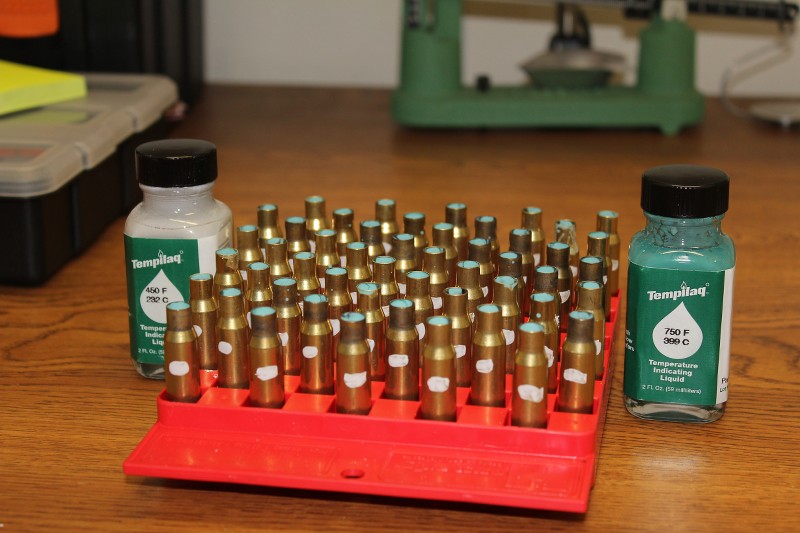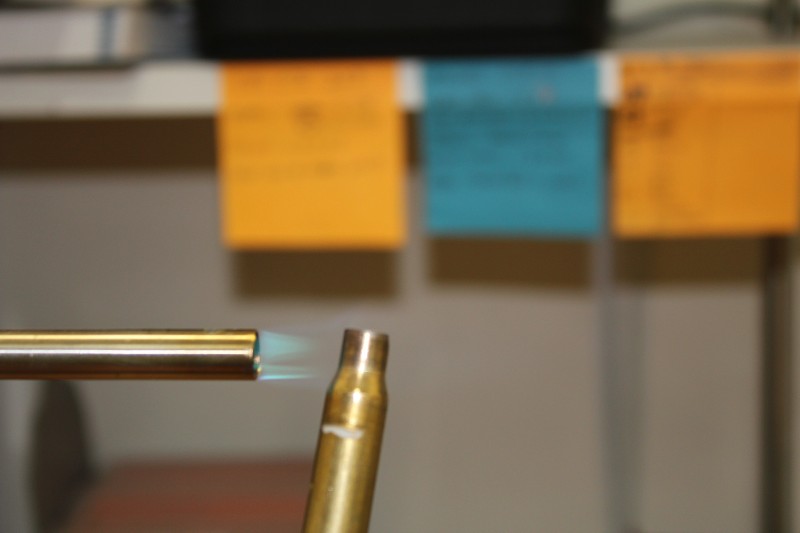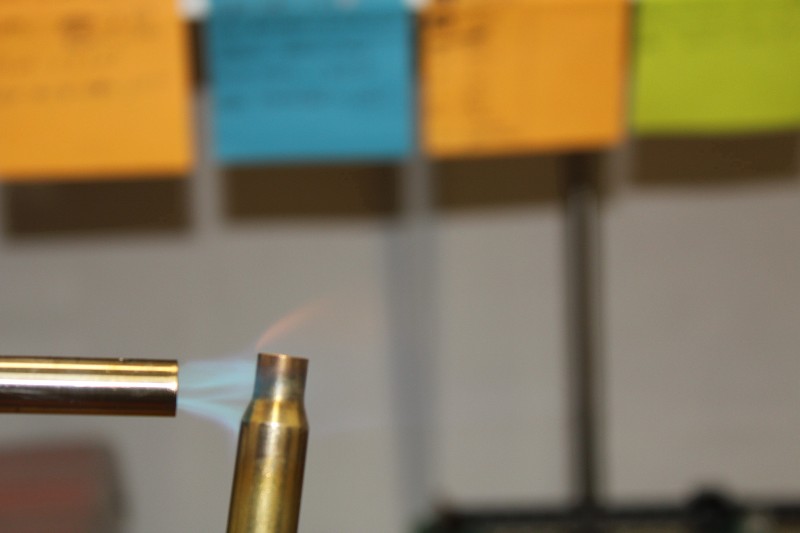
 |
|
|||||||
| Forum Rules | Firearms Safety | Firearms Photos | Links | Library | Lost Password | Email Changes |
| Register | FAQ | Calendar | Today's Posts | Search |
 |
|
|
Thread Tools | Search this Thread |
|
|
#1 |
|
Senior Member
Join Date: December 21, 2010
Location: Minnesota
Posts: 288
|
Annealing .223 - hitting the right temperature
I have a few thousand "twice fired" .223 cases to anneal. I picked up a Giraud tool annealing machine a few months ago and did some initial testing with some junk cases and 750 degree (green) TempilLaq.
It seems most of info and YouTube videos on the Intertubes concerning annealing is wrong: Lots of people saying TempiLaq turns black when it reaches temperature (and they put it on the outside of the case mouth, right in the flame), or heat the brass 'til it's cherry red and "temper" it with a cold water quench, etc... I went to the TempiLaq site and they have a very nice video of a flat piece of metal sitting in a very well lit oven. There's some TemiLaq on top. When the metal reaches the right temp, the TempiLaq liquifies and puddles. No glowing metal or black TempiLaq here. So after setting up my machine and running about a hundred junk cases through, I determined that there is no way I can see TempiLaq liquify on the inside of a .223 case mouth while it's rotating in a flame. Plan "B" was to compare case necks with TempiLaq that had heated and cooled down, to cases that had not been heated to see if I could see signs of spreading or movement of the green stuff that would indicate it went liquid at some point: No dice there either. So on to plan "C"... I ordered an infra-red thermometer from Amazon. It's got a pair of LED laser pointers that are supposed to indicate how wide of an area the thermometer is reading. They converge at about 27 inches from the lens of the thermometer. I'm hoping at that distance the thing will be reading an area slightly smaller than my case neck. I'm not one to trust a new piece of gear until it's proven. I have concerns that reading the case mouth while it's in the flame could induce errors. I don't have anything to calibrate this to, so I'm looking for a way to at least verify that I'm in the ballpark (plan "D"?), and not getting the necks too soft. A friend of mine says he anneals in the dark and stops as soon as the mouth just begins to glow (very) dull red. He's a pretty good shooter but I have no idea what his metallurgy skills might be. I know cherry red is too hot but I don't know what kind of "glow" would be close to 750. So what kind of glow (if any) would be close 750? Alternatively, is there a way to test case neck "softness" post annealing? I've seen the advice about squeezing cases with pliers and trying to feel differences but I'm looking for something more objective than "feeling".
__________________
The most feared gun control law proposal: Require buyers to register all gun purchases with their wives 
|
|
|
|
|
#2 |
|
Staff
Join Date: March 4, 2005
Location: Ohio
Posts: 21,063
|
You are at about 400°C. Most color temperature charts start with the deepest red at about 500°C, so the chances are your friend is heating further than necessary. This weakens the brass a bit, causing it to require more frequent annealing.
You should be able to paint the Tempilaq inside the case mouth. Aim the flame a little lower at junction of the neck and shoulder, so it doesn't impinge on the case mouth, and you should be able to see the stuff get more clear right as it melts. By the time the inside of the case mouth heats, the outside is a little warmer, so 700°F Tempilaq may be more appropriate. Polish the cases beforehand and look for the brass to just start changing to oxide colors (light blue) from yellow brass color. That's generally enough.
__________________
Gunsite Orange Hat Family Member CMP Certified GSM Master Instructor NRA Certified Rifle Instructor NRA Benefactor Member and Golden Eagle |
|
|
|
|
#3 |
|
Senior Member
Join Date: April 10, 2012
Location: San Diego CA
Posts: 6,876
|
Try 450* or 475* applied a 1/4" below the shoulder . Make sure it stays out of the flame . I have found if the flame/heat is adjusted right . The 750* inside the neck and 450* just below the shoulder melt at the same time .
I've done a good amount of testing and can say that if the case glows in any way it was much hotter then 750* I have some great photos showing all this but image shack is not working right now . If I can , I'll post pics later .
__________________
If Jesus had a gun , he'd probably still be alive ! I almost always write my posts regardless of content in a jovial manor and intent . If that's not how you took it , please try again .  
|
|
|
|
|
#4 | |
|
Senior Member
Join Date: December 21, 2010
Location: Minnesota
Posts: 288
|
Thanks for the reply!
Quote:
Should I be looking for the oxide/blue color change while it's in the flame or after the case has dropped?
__________________
The most feared gun control law proposal: Require buyers to register all gun purchases with their wives 
|
|
|
|
|
|
#5 | |
|
Senior Member
Join Date: December 21, 2010
Location: Minnesota
Posts: 288
|
Thanks for the reply!
Quote:
__________________
The most feared gun control law proposal: Require buyers to register all gun purchases with their wives 
|
|
|
|
|
|
#6 | |||
|
Senior Member
Join Date: April 10, 2012
Location: San Diego CA
Posts: 6,876
|
Quote:
Quote:
Quote:
This is tempilaq , It's liquid rather then the sticks . This was 50 - 308 cases I was doing test on to compare the two temperature locations . These cases have 750* inside the necks and 450* just below the shoulder .  The method I use is spinning the case in a socket using a screw gun while applying the heat with a torch . Although we are doing the same thing . Your machine is quite different and not all my observations will transfer directly over . I can say the actual heat of the flame means a great deal . Not so much that you will or will not anneal the case . Rather how quickly the neck and shoulder will be annealed , what the color of the case will be when done ( those cool anneal marks ) and what the flame looks like when the case reaches the correct temp . All three of these pics show the case and flame the exact moment the case reaches 750* inside the neck and 450* just below the shoulder . This first flame is a propane torch turned down quite low . You can see the flame never changes color  This pic show the propane torch turned up and the flame much hotter . As you can see the flame starts to change color as it reached the correct temp  This last flame is from a MAPP gas torch that burns much hotter then propane . The flame is very hard to control in the way needed to anneal rifle cases and as you can see gets really orange .  As you can see none of the cases got to the point of being red hot or even close to glowing in any way even though ALL reached the exact same temperature . You can also see the hotter flame in the third pic is causing the more pronounced anneal marks and the first pic shows when heated slower you get almost no anneal marks . As for the color change in the flame . After a bit of research and being apart of a few of these threads . I believe the orange flame is an indication that the zinc in the brass is starting to burn off . Uncle nick touched on the idea of the outside of the case heating faster then the inside do to the wall thickness . He likely could explain it better but It's my understanding if you have a very hot flame the outside heats faster then the inside and by the time the inside of the neck hits 750* the outside is past the zinc melting point of 778* . This causes the flame to change color . To be clear this is not to mean if the flame turns orange you are to hot or something went wrong . In fact if you use a temp indicator and the right heat you can use the start of that orange flame as your indicator to remove the case from the flame . My point really is that there is more then one way to anneal properly . It's my strong belief that you need some sort of temp indicator to use as a control sample to be sure your method is actually reaching the correct temp . Even the look of the cases does not tell you if the case reached the correct temp . I have a pic showing the difference there as well but image shack may have lost it . You'll just have to take my word for it .  My point is still the same . If you use the temp indicator . There are multiple ways - flame size , anneal marks , time in the flame . one flame , two flames . Hell just holding it in your fingers . All ways and different combo's can and will work . You just need a control sample using a temperature indicator to test your method to be sure your method which ever way that may be is heating the case to the correct temperature . Tempilaq http://www.midwayusa.com/product/321...50-degree-2-oz http://www.midwayusa.com/product/171...00-degree-2-oz http://www.midwayusa.com/product/988...50-degree-2-oz
__________________
If Jesus had a gun , he'd probably still be alive ! I almost always write my posts regardless of content in a jovial manor and intent . If that's not how you took it , please try again .  
Last edited by Metal god; November 28, 2015 at 12:29 PM. Reason: Added annealing links & quotes |
|||
|
|
|
|
#7 |
|
Senior Member
Join Date: December 21, 2010
Location: Minnesota
Posts: 288
|
I ran a batch of about 500 .223 cases through the annealing machine.
I could not see inside the .223 case mouths well enough to detect tempilaq melting. I did not see any orange appear in the torch flame until it was way too late judging by the glowing red brass. I did see the torch flame "reach around" into the case mouth at about the 6 second mark and ignite the tempilaq leaving white ash behind. I painted more cases inside their mouth with tempilaq making sure to keep it more than 1/8" from the mouth. The torch flame was also about 1/8" away from the mouth, centered on the middle of the shoulder. The flame still reached around. I decided this meant the tempilaq was releasing flammable vapor and had likely melted (impatience may have been a factor in this conclusion). I set the timer to dump the case just after "reach-around time" and ran 500. Color change in the neck and shoulder is similar to some Federal M193 rounds I have on hand but the color change area does not extend as far down the body as it does on the M193 rounds. Necks and shoulders of the annealed cases is still kind of shiny and not dull. I didn't have any shoulder collapses during resizing. I'll see how they shoot when it warms up a bit (-9F here right now).
__________________
The most feared gun control law proposal: Require buyers to register all gun purchases with their wives 
|
|
|
|
|
#8 |
|
Staff
Join Date: March 4, 2005
Location: Ohio
Posts: 21,063
|
I don't know which machine you are using (if you said in another thread, I've forgotten), but can you angle the flame a little from below the mouth toward the shoulder. That should both increase shoulder coverage and reduce the flame's propensity to enter the case mouth.
__________________
Gunsite Orange Hat Family Member CMP Certified GSM Master Instructor NRA Certified Rifle Instructor NRA Benefactor Member and Golden Eagle |
|
|
|
|
#9 |
|
Senior Member
Join Date: December 21, 2010
Location: Minnesota
Posts: 288
|
I have the Giraud machine.
__________________
The most feared gun control law proposal: Require buyers to register all gun purchases with their wives 
|
|
|
|
|
#10 |
|
Staff
Join Date: March 4, 2005
Location: Ohio
Posts: 21,063
|
I have his trimmer but not the annealer. Does the torch holder let you slide the torch closer to the maching and turn the head?
__________________
Gunsite Orange Hat Family Member CMP Certified GSM Master Instructor NRA Certified Rifle Instructor NRA Benefactor Member and Golden Eagle |
|
|
|
|
#11 |
|
Senior Member
Join Date: December 21, 2010
Location: Minnesota
Posts: 288
|
Yes. You can change the torch distance to/from the case, and pivot the torch to change the angle of the flame relative to the case.
I could pivot the torch to avoid the "reach-around" but the reach-around only happens with the painted cases that I use to for setting up the machine. Once it's set up, only unpainted cases are fed. If the reach-around is a valid indicator of the tempilaq having reached target temperature (I don't know how to prove that though), I'd like to keep it. I'm not really worried about how far down the the case body I get a color change.
__________________
The most feared gun control law proposal: Require buyers to register all gun purchases with their wives 
|
|
|
|
|
#12 |
|
Senior Member
Join Date: April 10, 2012
Location: San Diego CA
Posts: 6,876
|
In my test with the indicator inside the neck . It never seemed to melt as much as it just burnt off . The 450 on the outside clearly melted but the 750 really just seemed to change color .
What I'd do next now that you have your 6 sec theory is paint some necks up in batches of 3 to 5 and run them in the machine to drop at 4.5 sec , 5 sec , 5.5 sec , 6 sec , 6.5 sec and 7 sec . Then inspect each set of cases to see what the indicator looks like and see if you can tell at what time interval the 750 melted or changed color . I've not counted/timed it in awhile but seem to remember the 5 to 7 sec mark being about right depending on the flame heat . I'd say your likely close if not perfect .
__________________
If Jesus had a gun , he'd probably still be alive ! I almost always write my posts regardless of content in a jovial manor and intent . If that's not how you took it , please try again .  
|
|
|
 |
|
|